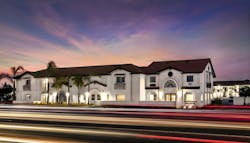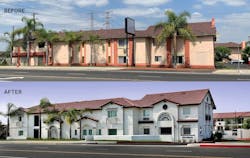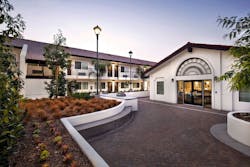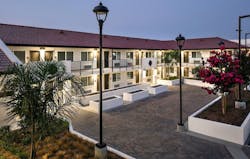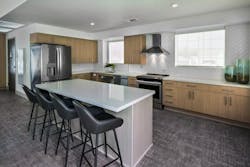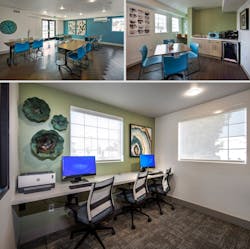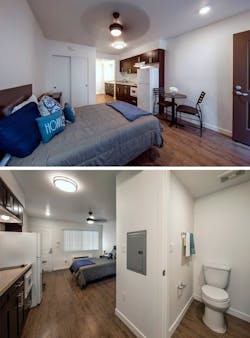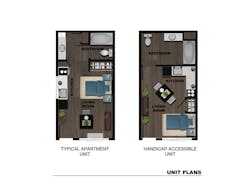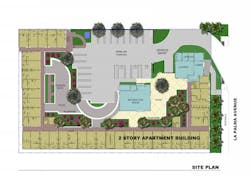Motel Conversion: A Motel Becomes a Model for Affordable Housing
When Jamboree Housing, an affordable housing nonprofit headquartered in Irvine, Calif., approached Manuel Salazar to renovate an obsolete Econo Lodge motel in nearby Anaheim, his first thought was that this adaptive reuse motel conversion would be simple to deliver. “I thought this would be just a kitchen update and new paint, but that’s not the Jamboree philosophy,” says Salazar, managing director and senior associate at Y&M Architects, in Los Angeles. “They wanted to create a home, a place where people will feel they’re better off.”
From Motel to Housing
Adaptive Reuse Project Specs for Buena Esperanza
Location: Anaheim, Calif.
Lot size: 1.04 acres
Total built size: 38,420 square feet
Unit sizes: 302 to 417 square feet
Developer and builder: Jamboree Housing, and Jamboree Quality Development and Construction, Irvine, Calif.
Architect: Y&M Architects, Los Angeles
Interior designer: JAG Interiors, Calabasas, Calif.
Landscape architect: Mark Beall & Associates, Los Angeles
Photos: Juan Tallo Photography
A Motel Conversion Takes Shape
To deliver that sense to residents, each of the 69 motel rooms on two levels was enhanced with larger windows, better lighting, and a lighter color palette to make them feel larger. The adaptive reuse project also included upgrades to bathrooms and kitchenettes with Energy Star-certified appliances—all in roughly 300-to-400-square-foot studio apartments (including some accessible units) that rent for less than $1,000 per month exclusively to residents earning 30% or less of the area’s average median income.
Repurposing the motel also included replacing or repairing its water-damaged exterior stucco and interior drywall, transforming the look of the tired building into a vibrant, attractive Spanish hacienda-style design. The look suits the property’s new name, Buena Esperanza, which means “Good Hope.”
“I like the idea of taking old, abandoned hotels and transforming them into housing for formerly homeless people.” —Manuel Salazar
“We deliberately kept the units small to encourage residents to interact in the communal spaces,” Salazar says, referring to what Jamboree calls “wraparound services,” including a new 1,800-square-foot community center with a computer lab, communal kitchen, living area, laundry facilities, and rooms for counseling and teaching life skills.
The motel’s old lobby now houses smaller communal, learning, and office spaces and the footprint also now features a community garden. “The amenities and service spaces were a priority to create a place where people could thrive,” Salazar says. “Community-building is essential to help this population.”
RELATED
- Niche Design Ideas for Greater Livability—and Coziness
- From Infill Lot to Urban Oasis: Home Design That Maximizes a Compact Site
- Design Trends to Watch From the 2022 Best in American Living Awards
Motel Adaptive Reuse: Not So Easy
While the challenge for Salazar was to create a community from what was essentially an institutional building, the Jamboree team needed to develop financing and services partnerships to pull off the motel-to-housing conversion.
“There was a big push in Orange County and from the state to fund permanent, supportive housing for formerly homeless people,” says Michael Massie, chief real estate development officer for Jamboree Housing. “The idea was that reusing a motel would be both cheaper and easier than a ground-up development, but it wasn’t quite as easy or as cheap as we thought.”
Jamboree coordinated financing from multiple sources, including private funding from Disneyland and U.S. Bank, along with Low Income Housing Tax Credits and public funds from California, the City of Anaheim, Orange County, and the U.S. Department of Veterans Affairs.
Though it pitched in financially, the city was initially skeptical about the size of the units, Massie says, which altered the project's scope a bit. “City officials encouraged us to take away more parking and build more community space for the residents,” he says. “We had to draw up a new ordinance with the city and the planning department because the land was entitled for commercial use instead of residential.”
In repurposing the motel for housing, the project team also had to convince skeptical neighbors that Buena Esperanza would improve the area. All of the 69 furnished studio units are reserved for veterans, individuals living with mental illness, and formerly unhoused people. “A lot of people didn’t want homeless people moved into that location, but when we revealed the look and vision for Buena Esperanza, that helped change minds in the community,” Salazar says. No doubt, the adaptive reuse project improved the trek along La Palma Avenue, a major commercial/industrial corridor in Anaheim, and the motel conversion to housing complements newer residential development across the street.
In recognition of its success, Buena Esperanza won a Platinum Award and a Community Impact Award in the 2022 Best in American Living Awards (BALA) Multifamily Adaptive Reuse category. More importantly, this adaptive reuse motel conversion served as the prototype for the $2.75 billion expansion of California’s Homekey program, which funds the acquisition of obsolete motels and renovates them to get people off the street and help transition them to permanent supportive housing, Massie says.
Michele Lerner is an award-winning real estate journalist in the Washington, D.C., area.
